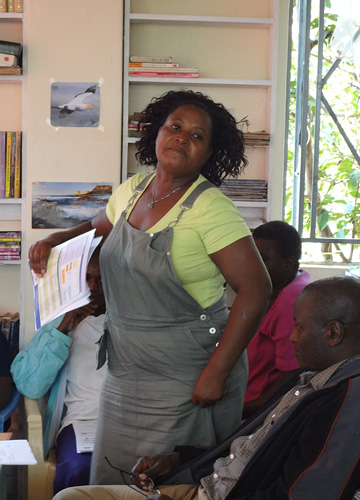#02 Initiatives in Kenya
Following on from last year's visit, in May of this year we returned to Kenya.
A green landscape extends from a workshop housing producers.May in Kenya's Kisii District is the rainy season, but there are sunny intervals when the rain stops. The climate is cool in the morning and evening, but hot during the daytime.
On this visit, we continued for six hours by car from Nairobi until we arrived at Kisii for workshop observations, seminars and meetings. The group of producers here comprises approximately 200 people, with a gender split of 60% women and 40% men. Due to the properties of the soapstone (stone) material, the men carry out soapstone extraction, transport, rough cutting, and formation of final shapes, etc., and the women take care of the subsequent polishing and washing processes. Particularly in this region, there are many home-based producers who operate outside of office and workshop locations. This is an excellent model for the production of items in villages, as local materials are used for local production of goods that will then be sold outside the region.
 We saw women washing soapstone while also raising children and tending to stores, etc.
We saw women washing soapstone while also raising children and tending to stores, etc.
Last year, we actually collected at our office various items that had been produced externally at the houses of artisans, etc. This approach meant that in relation to production control we were unable to accurately ascertain the number of finished products, and in spite of having decided on a sales period for Christmas gifts, there remained issues regarding delivery deadlines. This year, we dealt with these issues in cooperation with JICA Kenya, gained recognition from the leaders of production organizations, and made changes so that consistent production control would be conducted under technology/QA leaders at workshops in the same locations as offices, thereby ensuring that we can accurately ascertain the number of finished articles.
On this visit, a "Kickoff Workshop" was held for the just under 50 producer members at the workshop. Together with JICA and the Ministry of Industrialization, we also introduced ourselves with an explanation of the history and concept behind MUJI, reported on sales results for last year's products and outlined relevant issues, and explained the concepts and quality-related points in relation to the items that producers will make this year.
 The seminar was conducted with translation from English into the Kisii language
The seminar was conducted with translation from English into the Kisii language
 In terms of quality, for example, we found that candles of different heights were being distributed in Japan
In terms of quality, for example, we found that candles of different heights were being distributed in Japan
and Europe/Africa. Differences, however slight, occurred due to small disparities in the depth
and size specifications that had been established to ensure that candles would be properly sorted.
The producers and artisans no doubt wanted to hear about where and how their own products are being sold, with what kind of concept, and to what response. Everyone paid keen attention.
 Producers and artisans listening keenly
Producers and artisans listening keenly
All of the producers introduced themselves, stating their names and the manufacturing processes for which they are responsible.

We were also able to meet with all of the producers and artisans who so carefully produce these items, and seeing for ourselves on-site how they are making improvements and devising production only reinforced our desire to make efforts geared towards the places where their products will be sold. Since it is essential to keep on selling in order to continue, the importance of producing plans and designs that will sell was reaffirmed.
We also received a variety of requests from the producers, including practical details such as wanting diagrams to be drawn in units of cm rather than mm (in fact, specifications in mm had not been used locally, resulting in errors in recognizing units, etc.) and matters relating to guaranteed on-time delivery.
Through face-to-face communication, including hearing requests from producers and Q&A sessions, we were able to gain an understanding regarding mutually important quality-related points and delivery deadlines, both for production this year and beyond.
In a later development, products were actually finished and shipped in July ahead of schedule. This provided us with a valuable lesson in the importance of sharing objectives, consideration of how to do so, and the importance of making plans.
During this visit we saw improvements in the working environment compared with last year, including roofs where previously there were none, and seating for people working on packing/polishing processes where previously they sat directly on the ground.
Furthermore, the producer organization has properly implemented the plans it proposed during last year's visit with regards to the establishment of a library and computer room on top of its office to serve as a hub for the community. While the quantity of books available still needs to be increased, we did see signs of steady development with the local community.
 The computer room was being used by young people from the local area
The computer room was being used by young people from the local area
 There is still a need for more books, but the library is in place
There is still a need for more books, but the library is in place
 Project members with producers and artisans
Project members with producers and artisans
After arriving in Japan, these products are inspected and packed before being shipped domestically and overseas. Now, in August, we are awaiting the arrival of these products as they are delivered by ship. We will be able to introduce these products to everyone this Christmas, so please look forward to seeing what is in store.
Reference article: Japanese company opens doors to Kisii products.![]()



